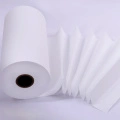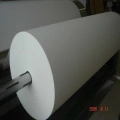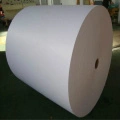Fiberglass air filter paper has become a cornerstone in modern air filtration systems due to its exceptional performance in capturing particulate matter while maintaining low air resistance. Manufactured using a wet-forming method, this material is composed of glass microfiber wool, offering a unique combination of durability, efficiency, and versatility. The product is categorized into three primary series—ASHRAE, HEPA, and ULPA—each tailored to specific filtration requirements. This article explores the technical specifications, applications, and industry relevance of fiberglass air filter paper, while highlighting the expertise of its manufacturer, Hebei Fangyu Filters Material Technology Co., Ltd..
Fiberglass air filter paper is engineered to deliver high dust-hold capacity and low resistance, making it ideal for a wide range of applications. The material’s fiber distribution ensures uniform filtration efficiency, while its high tensile strength and stiffness provide structural integrity. These properties make it a preferred choice for both industrial and residential air filtration systems.

Image 1: Fiberglass air filter paper with its unique microfiber structure.
The product is classified into three series based on filtration efficiency:
The technical specifications of fiberglass air filter paper are meticulously designed to meet industry standards. Below is a detailed table outlining the key parameters for each classification:
| Classification | Grade | Efficiency (%) | Basic Weight (g/m²) | Thickness (mm) @100kPa | Air Resistance (Pa) @5.3cm/s | Tensile Strength (N/m) MD | Stiffness (mg) MD |
|---|---|---|---|---|---|---|---|
| ASHRAE | FY-F9 | 95 | 70 | 0.34 | 55±10 | 1200 | 1200 |
| FY-F8 | 90 | 70 | 0.34 | 35±5 | 1200 | 1200 | |
| FY-F7 | 80 | 70 | 0.34 | 33±5 | 1200 | 1200 | |
| FY-F6 | 60 | 70 | 0.33 | 20±5 | 1200 | 1200 | |
| HEPA | FY-H14 | 99.995 | 70 | 0.34 | 340±20 | 1200 | 1000 |
| FY-H13 | 99.97 | 70 | 0.34 | 290±20 | 1200 | 1000 | |
| FY-H12 | 99.8 | 70 | 0.34 | 250±20 | 1200 | 1000 | |
| FY-H11 | 98 | 70 | 0.34 | 120±20 | 1200 | 1000 | |
| FY-H10 | 94 | 70 | 0.34 | 80±15 | 1200 | 1000 | |
| ULPA | FY-U17 | 99.9999 | 73 | 0.37 | 500±20 | 1200 | 1000 |
| FY-U16 | 99.9999 | 73 | 0.37 | 440±20 | 1200 | 1000 | |
| FY-U15 | 99.999 | 73 | 0.37 | 390±20 | 1200 | 1000 |
The specifications highlight the material’s adaptability to diverse filtration needs. For instance, the ULPA series achieves ultra-high efficiency, making it suitable for semiconductor manufacturing, while the ASHRAE series balances cost-effectiveness with performance for general HVAC systems.

Image 2: HEPA filter paper manufacturing process.
Fiberglass air filter paper is utilized in a broad spectrum of applications, driven by its ability to meet stringent filtration standards. Key areas include:
The HEPA filter paper for sale is particularly valued in nuclear facilities and high-end vacuum cleaners, where even the smallest particles must be captured. Meanwhile, the fiberglass filter paper is a staple in paint spray booths and photographic film manufacturing, where precision is paramount.

Image 3: Fiberglass filter paper in a cleanroom environment.
As a leading manufacturer of filtration materials, Hebei Fangyu Filters Material Technology Co., Ltd. has established itself as a trusted name in the industry. The company specializes in producing high-quality air filter media, including fiberglass, HEPA, and ULPA filters, adhering to international standards such as EN779 and ISO16890. With a commitment to innovation and quality, Hebei Fangyu ensures its products meet the demands of both industrial and consumer markets.
Hebei Fangyu’s expertise is evident in its ability to customize solutions for specific applications. For example, the hepa filter paper manufacturers at the company are equipped to handle complex filtration challenges, from semiconductor production to medical device manufacturing.
The performance of fiberglass air filter paper is aligned with industry standards, ensuring reliability and consistency. According to the National Institute of Standards and Technology (NIST), filtration efficiency is a critical parameter in evaluating air quality control systems. NIST’s research underscores the importance of materials like fiberglass filter paper in maintaining compliance with air quality regulations and improving public health outcomes.
As highlighted in NIST publications, the integration of advanced filtration technologies is essential for reducing airborne contaminants in both industrial and residential settings. Fiberglass air filter paper, with its high efficiency and low resistance, exemplifies the kind of innovation that supports these goals.
Fiberglass air filter paper stands out as a versatile and high-performance solution for air filtration across diverse applications. Its technical specifications, combined with the expertise of manufacturers like Hebei Fangyu Filters Material Technology Co., Ltd., ensure that it meets the evolving demands of modern industries. Whether in cleanrooms, HVAC systems, or industrial equipment, this material continues to set benchmarks for efficiency and reliability.
For more information on fiberglass filter paper or to explore hepa filter paper manufacturers, visit the company’s website. Stay updated on the latest advancements in filtration technology and discover how these solutions can enhance your operations.
Thickness:0.2-6 mm or Customized
Strand Thickness:0.5-8mm
Swd:2.5-100mm Lwd: 4.5-200mm
Surface Treatment:Powder Coated,Galvanized
MATERAL: PHENOLIC PAPER
MELT-BLOWN PBT
NON-WONEN LAMINATES
DIESEL FUEL FINE FILTERATION GRADE
APPLICATION : FUEL OIL WATER SEPERATION FILTER MEDIA
Material: Electrostatic cotton with activated carbon
PET/PP with Activated Carbon
Basic weight: 200-800g/m2
Application: Cabin Air Filters Panel Air Filters, Filter Cartridge, etc.
RAW MATERIAL: Polypropylene
PROCESS TECHNOLOGY: Melt-blown non-woven
RANGE OF EFFICIENCY: M5 ~ H11
Jul,2025,31
Jul,2025,31
Jul,2025,31
Jul,2025,31
Email to this supplier

